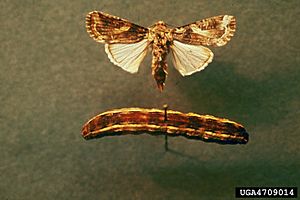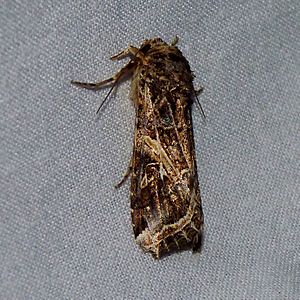Yellow-striped armyworm facts for kids
Quick facts for kids Yellow-striped armyworm |
|
|---|---|
 |
|
 |
|
| Scientific classification | |
| Synonyms | |
|
Spodoptera ornithogalli is a type of moth often called the yellow-striped armyworm or cotton cutworm. It belongs to the family Noctuidae, which includes many night-flying moths.
When this moth was first found, people thought it was the American version of a similar moth called S. littoralis. However, S. ornithogalli has a darker body and clearer patterns on its wings.
Contents
Discovering the Yellow-Striped Armyworm
The yellow-striped armyworm moth was first described in 1852 by a scientist named Achille Guenée. He gave it the scientific name Spodoptera ornithogalli. This name helps scientists around the world know exactly which moth they are talking about.
What Does This Moth Look Like?
The adult yellow-striped armyworm moth has a wingspan of about 32 to 44 millimeters. This means that when its wings are fully spread out, they measure between 1.25 and 1.75 inches across. These moths are usually seen flying from April to November, depending on where they live.
Where Do These Moths Live?
Yellow-striped armyworm moths can be found in many parts of the world. They are most common in North and South America.
Moths in North America
You can find these moths in many places across Canada, Mexico, and the United States. They live in states like California, Florida, Texas, and many others.
Moths in Central America and the Caribbean
These moths also live in countries throughout Central America and the islands of the Caribbean. This includes places like Costa Rica, Cuba, Jamaica, and Puerto Rico.
Moths in South America
In South America, the yellow-striped armyworm moth is found in countries such as Argentina, Brazil, Colombia, and Peru.
Moths Around the World
Sometimes, these moths are found in other parts of the world, like Denmark in Europe or Japan in Asia. However, they usually arrive there by accident, often on plants or goods being shipped. This is called a "port interception" by plant health experts. It means the moths are stopped before they can start living and spreading in these new areas. So far, they haven't settled down in Europe or Asia.
What Do Yellow-Striped Armyworm Larvae Eat?
The young moths, called larvae or caterpillars, are known to eat a wide variety of plants. They are sometimes considered pests because they can damage many important crops.
Favorite Food Plants
The larvae enjoy eating many different crops that humans grow. These include:
- Vegetables like corn, cabbage, cucumber, onion, pea, potato, sweet potato, and tomato.
- Field crops such as alfalfa, cotton, soybean, sunflower, and wheat.
- Fruits like grapes and watermelon.
- Other plants like tobacco and hops.
Other Plants They Eat
Besides crops, the larvae also feed on ornamental plants, which are grown for their beauty. These include chrysanthemums and roses. They also eat common weeds found in fields and gardens, such as Amaranthus retroflexus and Chenopodium album.


